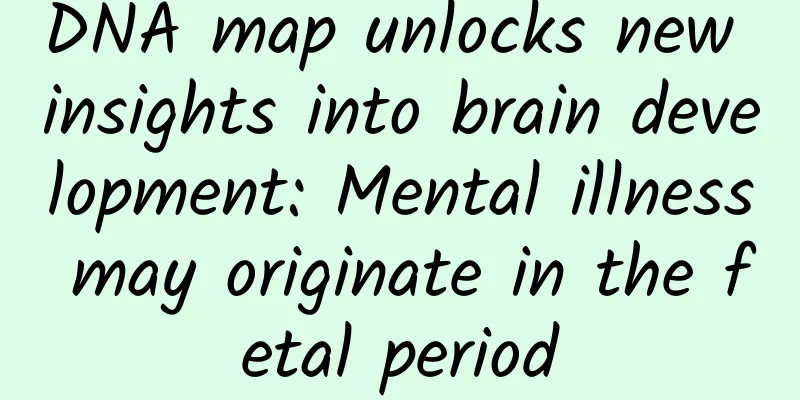DNA map unlocks new insights into brain development: Mental illness may originate in the fetal period

|
Tuchong Creative The human brain is one of the most complex organs in the human body, responsible for processing and coordinating all our thoughts, feelings, behaviors and body functions. Its growth and development are closely related to our physical and mental health. Recently, scientists have discovered that some mental illnesses may be related to the development of the brain during the embryonic period. Fetal brain development is a "big project". More than 4,000 nerve cells appear in the fetal brain every second, and 30,000 synaptic connections are formed per second within a square centimeter, a speed that even the current Internet communication cannot reach. The adult human brain contains hundreds of cell types, showing extraordinary diversity of molecular, morphological, anatomical and functional characteristics. Although most cortical neurons are produced in early and mid-pregnancy, the unique molecular characteristics of cell types appear between late pregnancy and adolescence. Single-cell and large-scale transcriptome analyses show that there is a significant remodeling of gene expression in late pregnancy and early postnatal development. Does early brain development affect physical and mental health? A study published in Molecular Psychiatry, a top journal in the field of psychiatry in 2021, gave a positive answer. Research from investigators at Cornell Medical College in the United States showed that various changes in brain cells in the first month of embryonic development may lead to schizophrenia in the future. This study fills an important gap in the understanding of schizophrenia and broadens the thinking. Because we have always believed that schizophrenia is more common in middle-aged and elderly people, but this study believes that this disease is likely to appear in the early stages of life growth and development. Recently, the first map of DNA modifications in the hippocampus and prefrontal cortex has provided further evidence. On October 9, a related study led by the University of California, Los Angeles was published in the journal Nature, revealing how gene regulation evolves during human brain development and showing the key role played by the 3D structure of chromatin. The researchers have drawn the first map of DNA modifications in the hippocampus and prefrontal cortex, providing new insights into how early brain development affects physical and mental health. The prefrontal cortex and hippocampus affect our mental and psychological state, and they begin to develop as early as the embryonic period. The prefrontal cortex acts as the CEO and commander in the brain, assisting various parts of the nerve center to complete organizational, directive and creative activities, and plays an important role in memory, judgment, analysis, thinking, operation, etc. The hippocampus is the cache and spatial navigation expert in our brain. It is not only responsible for converting short-term memory into long-term memory, but also participates in the formation of spatial memory and is closely connected with emotional memory. The hippocampus and prefrontal cortex play an important role in learning, memory and emotional regulation, and are also closely related to diseases such as autism and schizophrenia. To draw a DNA "blueprint" of the prefrontal cortex and hippocampus, the researchers used a cutting-edge sequencing method, namely single-nucleus methylation sequencing and chromatin conformation capture technology. This technology can simultaneously analyze two epigenetic mechanisms that control gene expression in individual cells. To understand the key to neuropsychiatric diseases, we must figure out how they act on genes that affect development. The researchers analyzed more than 53,000 brain cells provided by donors from mid-pregnancy to adulthood, revealing major changes in gene regulation during critical developmental windows, and constructing a comprehensive picture of the huge genetic reorganization that occurs at critical time points in human brain development. The most active phase of a baby's brain development occurs around the second trimester, researchers say. Neural stem cells called radial glial cells have already produced billions of neurons during the first and second trimesters. At this point, they stop producing neurons and begin producing glial cells that support and protect neurons. At the same time, newly formed neurons gradually mature, acquire the characteristics needed to perform specific functions, and form synaptic connections for communication. Neuropsychiatric disorders, including those that emerge in adulthood, often stem from genetic factors that interfere with early brain development. This map provides a baseline that can be compared with genetic studies of brains affected by the disease and pinpoints when and where molecular changes occur. Now that researchers have identified associations between different cell types, this discovery may help identify meaningful genetic risk factors in neurodevelopmental and neuropsychiatric diseases, and has important implications for improving stem cell-based models such as brain organoids. Cultivating a healthy human brain is a great feat. The embryo begins to develop from the size of a sesame seed, and begins a 40-week "magical journey" in the mother's body. During this period, the brain structure of the little life becomes more complex and sensitive. Although the new discovery is just the tip of the iceberg of brain gene research, and research on the origin, development and function of the human brain will continue, this new study has established an important database. In the future, there are still many unknown "secrets" about the embryonic brain waiting for us to explore. This article is a work supported by the Science Popularization China Creation Cultivation Program. Author: Chen Dingxin Reviewer: Gui Yaxing, Chief Physician, Department of Neurology, Shanghai First People's Hospital Produced by: China Association for Science and Technology Department of Science Popularization Producer: China Science and Technology Press Co., Ltd., Beijing Zhongke Xinghe Culture Media Co., Ltd. |
<<: Urinating in the Shower: Health Effects and the Science Behind It
>>: “Irradiated food” is related to radiation. Is it harmful to the human body if eaten?
Recommend
There is a bump next to the labia
Many women don't care about pimples on their ...
My stomach feels cool to the touch
Why does my lower abdomen feel cold? There are tw...
Can I eat cod during menstruation?
With the improvement of living standards, many pe...
Will the peak come early? Will children with mycoplasma pneumonia develop "white lungs"? Latest reminder
Autumn and winter are the peak seasons for respir...
How to restore vision during confinement
Good health is the most important thing, and most...
How to get rid of accessory breast on one side
In daily life, many women wear underwear, but som...
Is enema necessary for caesarean section?
People who have some experience in natural childb...
Does hyacinth bloom only once? How to cut hyacinth after it blooms?
As people's quality of life improves, more an...
Implantation bleeding after a few days
After marriage, every female friend hopes to have...
What should women pay attention to when they have kidney cysts
Renal cysts are a common symptom of kidney functi...
What kind of wine is champagne? How to hold a champagne glass
Champagne is a classic sparkling white wine. High...
Feminine hygiene products
Nowadays, many female friends use women's pri...
Is a cervical exam painful? That’s what people who have experienced it say!
In order to check the health of the cervix, women...
The benefits of drinking red wine every night for women
Red wine is a common type of alcoholic beverage. ...
comScore: Key data of the US mobile communications industry in Q3 2012: Samsung's market share is 26.9%
On the morning of January 4, 2012, market researc...









